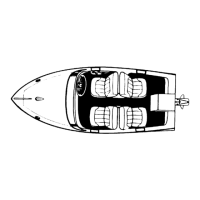CLOSED COOLING MODELS - 6B-3590-823225--1 1096
4. Disconnect heat exchanger-to-circulating pump
hose from pump and allow coolant to drain.
a
b
Typical Engine Shown
a - Heat Exchanger
b - Heat Exchanger-to-Circulating Pump Hose
5. After coolant has drained completely, reconnect
hose, but, do not tighten hose clamps.
6. With drain plugs still removed, flush closed cool-
ing section with plain water until discharge water
is clear.
7. Disconnect heat exchanger-to-circulating pump
hose once again and drain water.
8. After water has drained completely, apply Perfect
Seal to threads of drain plugs and reinstall. Re-
connect hose. Be sure to tighten drain plugs and
hose clamps securely. Refill section with coolant,
as explained following.
FILLING INSTRUCTIONS
!
CAUTION
Alcohol or Methanol base antifreeze or plain wa-
ter, are not recommended for use in coolant sec-
tion of Closed Cooling System at any time.
It is recommended that coolant section of Closed
Cooling System be filled with a 50/50 mixture of ethy-
lene glycol antifreeze and pure, soft water. Antifreeze
MUST BE used regardless of whether freezing tem-
peratures are or are not expected to provide ade-
quate corrosion protection. In areas where ethylene
glycol antifreeze is not available and the possibility of
freezing DOES NOT exist, it is permissible to use a
solution of rust inhibitor and pure, soft water (mixed
to manufacturer’s recommendations).
NOTE: Coolant section capacity is approximately 4
U.S. Gallons (15 L).
1. Fill coolant section of Closed Cooling System
with coolant mixture as follows:
a. Open bleeder valve on thermostat housing.
b. Fill with coolant mixture through heat ex-
changer fill neck until coolant appears at
bleeder valve opening.
c. Close bleeder valve securely.
d. Continue filling until coolant level is into filler
neck and begins to flow into coolant recovery
bottle plastic tubing.

